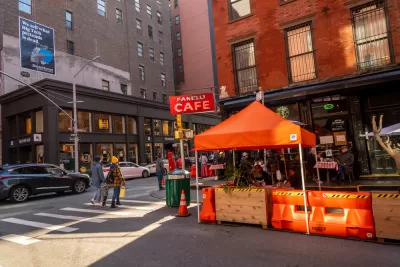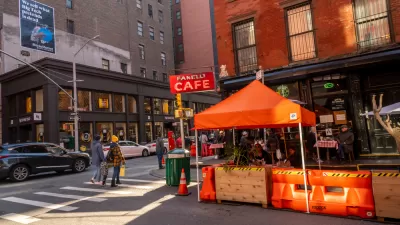New York City's Open Restaurants Program, while here to stay, is going to see substantial changes, requiring new permits, as soon as next year.

"Outdoor sheds, igloos and heated cabanas — hallmarks of New York City’s pandemic-era restaurant scene — may soon be a thing of the past," write Alicia Diaz and Kate Krader in the provocative lede to a Bloomberg CityLab story about the future of New York City's outdoor dining program.
While the city declared its outdoor dining program, known as the Open Restaurants Program, permanent back in September 2020, the city is still searching for a balance after "complaints over trash, rats, noise and fewer parking spaces have incited a push for a more regulated approach to the outdoor structures," according to Diaz and Krader.
Now, the city wants to move away from the permanent encampments of shipping containers or plywood shacks with sliding doors and heating systems, potentially toward a more European streetscape of bistro tables and colorful umbrellas that can be removed at closing time. The idea is to find a compromise between cultivating a vibrant hospitality industry, while keeping residents happy.
Changes could be coming in 2023, according to the article. "[T]he City Council envisions a permanent program that would expand access to sidewalk dining and allow many of the businesses approved under the pandemic emergency measures included in the original Open Restaurants Program to reapply for permits, according to a zoning amendment approved in February," according to the article.
More details on the political and economic debate about the city's outdoor dining program are included in the source article below.
FULL STORY: Inside the Fight Over the Future of New York City’s Outdoor Dining

Alabama: Trump Terminates Settlements for Black Communities Harmed By Raw Sewage
Trump deemed the landmark civil rights agreement “illegal DEI and environmental justice policy.”

Planetizen Federal Action Tracker
A weekly monitor of how Trump’s orders and actions are impacting planners and planning in America.

Why Should We Subsidize Public Transportation?
Many public transit agencies face financial stress due to rising costs, declining fare revenue, and declining subsidies. Transit advocates must provide a strong business case for increasing public transit funding.

Judge Orders Release of Frozen IRA, IIJA Funding
The decision is a victory for environmental groups who charged that freezing funds for critical infrastructure and disaster response programs caused “real and irreparable harm” to communities.

‘Clybourne Park’ Sets Stage for Housing Equity Discussions
Clybourne Park, a play exploring race, real estate, and community tensions, can set the stage for discussion on the lasting impacts of housing discrimination, gentrification, and the fight for affordability.

Understanding Road Diets
An explainer from Momentum highlights the advantages of reducing vehicle lanes in favor of more bike, transit, and pedestrian infrastructure.
Urban Design for Planners 1: Software Tools
This six-course series explores essential urban design concepts using open source software and equips planners with the tools they need to participate fully in the urban design process.
Planning for Universal Design
Learn the tools for implementing Universal Design in planning regulations.
Caltrans
Smith Gee Studio
Institute for Housing and Urban Development Studies (IHS)
City of Grandview
Harvard GSD Executive Education
Toledo-Lucas County Plan Commissions
Salt Lake City
NYU Wagner Graduate School of Public Service




























